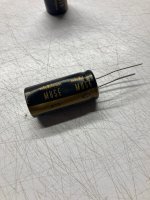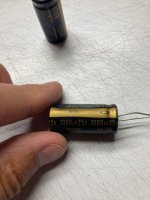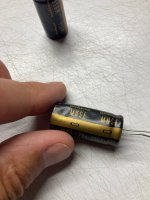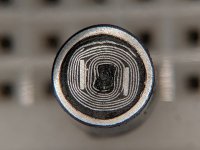Hi. I've got a pair of 1000uF relatively low voltage Nichicon Muse capacitors with dents in them. I've had them for years at this point without knowing they were dented. They were part of a kit and not worth bothering the kit maker over, so. I'm trying to decide if they're usable in say the early stages of a low voltage power filtering circuit. With a cheap LC meter, they measure within spec, e.g. ~10% down of rating. There is this older thread discussing film caps with shipping damage and opinions seemed somewhat mixed.
Attachments
...had them for years....dent....
Those are cheap caps, so why bother with them and take unnecessary risks?
Those are cheap caps, so why bother with them and take unnecessary risks?
Well, I'm a reuse guy, it's a bit of an aesthetic principle with me. That aside let me clarify I'm looking for a technical opinion, not economic.
If they measure the labeled capacitance within ±20 % at least the capacitance is good. But the dents will have caused the foil inside to deform, so all bets are off regarding the voltage rating. Personally I would toss them. I would definitely not use them in a power supply. They may be useful for decoupling capacitors as long as the voltage across them isn't more than a few volt.
I understand your desire to reuse and minimize your impact. I try my best to do that as well. But this is one of those times where the phrase "penny wise, pound foolish" comes to mind.
Tom
I understand your desire to reuse and minimize your impact. I try my best to do that as well. But this is one of those times where the phrase "penny wise, pound foolish" comes to mind.
Tom
Small dents like that are unlikely to be any issue - once you know what's inside you'll realise its pretty resilient to a bit of squashing.
The attached cross section suggests there's space between the aluminium can and the internal foil that should accommodate a small dent.
Attachments
So, thank you @Galu . This gets at the crux of what was bugging me, which is how could these things even dent like this in the first place. There wasn't any damage to the packaging or any of the other components that I can remember which might indicate a hit or compression event hard enough to squish a cap. Also the fact that two of the four in the kit had very similar dents, almost implied that this was a capacitor packaging issue and not necessarily a damage event. I deliberately didn't lead with that when I posted this as I wasn't looking for confirmation bias. But no one so far has volunteered with something like "oh that's a common issue seen with Muse caps" or the like, which might suggest a more benign condition than damage & shorting risk.
* as long as the dent does not cause the square corner of the electrodes to smash through the electrolytic-soaked paper dielectric. Without X-ray vision (or actual X-ray imaging) there's no way to tell. Unless you want to take the cap apart.The attached cross section suggests there's space between the aluminium can and the internal foil that should accommodate a small dent.
Tom
A rule-of-thumb is that the cost of fixing a failure increases by 10x at every step from component to board to box to system.
Fix this failure-to-be while it is still in the component stage.
Ed
Fix this failure-to-be while it is still in the component stage.
Ed
Some manufacturers lightly and uniformly crimp the cans down onto the internal roll to prevent movement and better withstand vibration.Why do some large electrolytic capacitors have regularly dented cans
You will notice that the crimps are not sharply formed in order to protect the windings,and additional insulation is generally used for safety and cushioning.
There isn't always the amount of space shown in that pic above. I've pulled electrolytics apart where the foil roll only just fitted inside the can, with there being a slight suction when removing the innards because of the wet electrolyte.
When in doubt throw them out.. Sorry 😀 Joking aside I avoid parts that I might knowingly have to replace in the near future.
Don't count on there being internal clearance, or no damage to the internal insulators. Depending on where they are used there is always the possibility of a catastrophic event that could damage other nearby components.
Don't count on there being internal clearance, or no damage to the internal insulators. Depending on where they are used there is always the possibility of a catastrophic event that could damage other nearby components.
- Home
- Design & Build
- Parts
- Dented electrolytics




